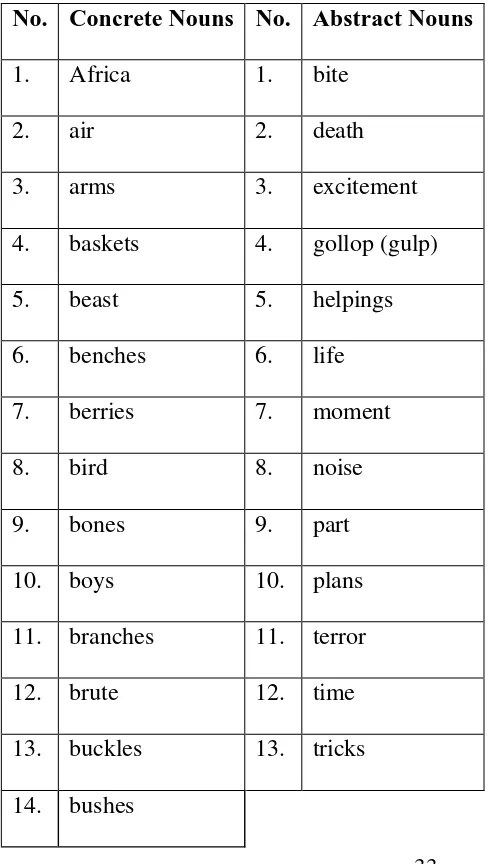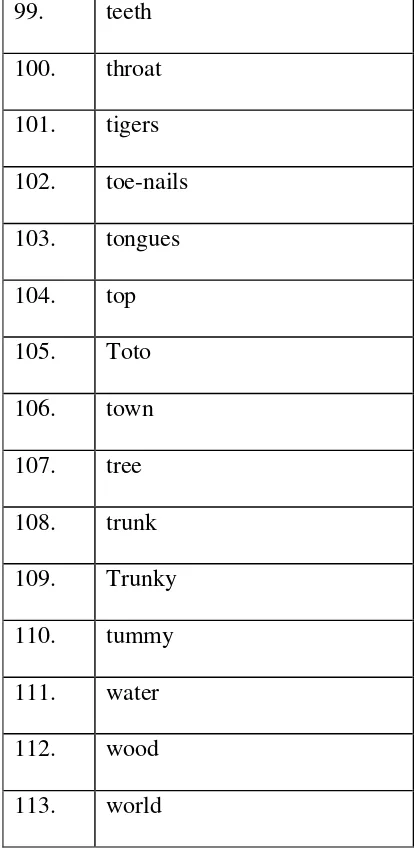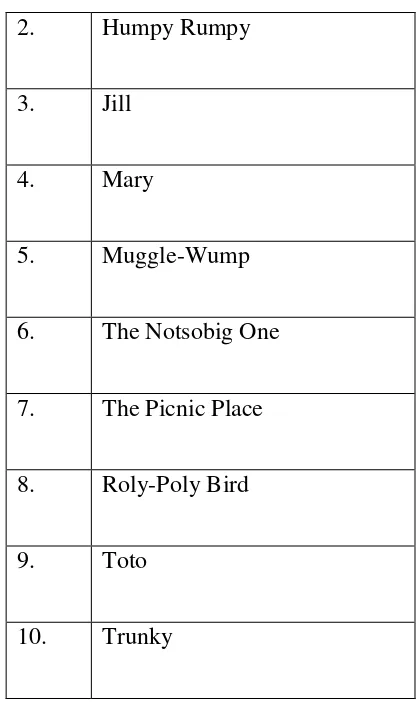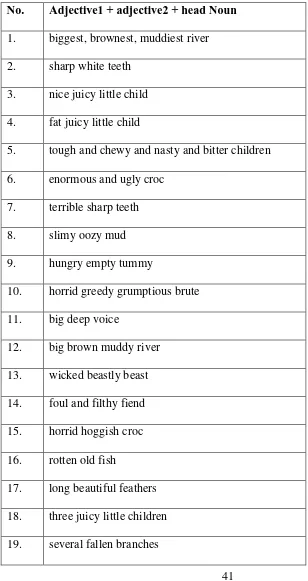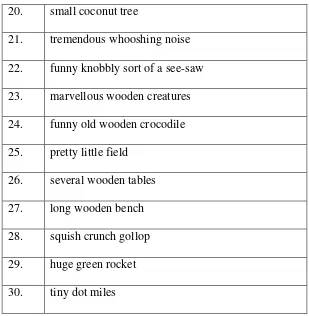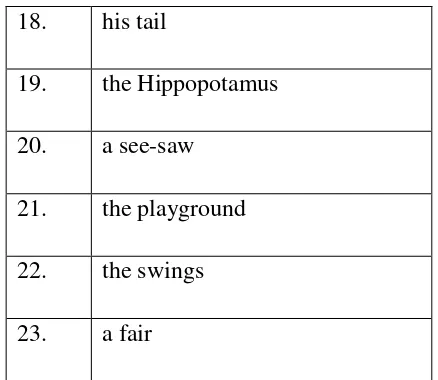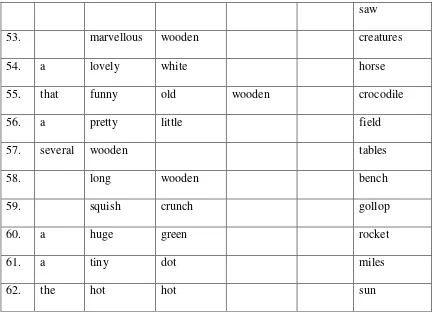iii
Maranatha Christian University
ABSTRACT
Dalam skripsi ini saya menganalisis penggunaan teori Stilistika dan kategori Stilistika dari sebuah novel anak-anak karya Roald Dahl. Roald Dahl terkenal akan kemampuannya dalam menciptakan cerita-cerita yang luar biasa, salah satunya adalah The Enormous Crocodile.
The Enormous Crocodile adalah cerita tentang seekor buaya raksasa, makhluk
paling rakus di hutan Afrika dan suka sekali makan anak-anak. Dia juga suka menganggap dirinya sangat pintar karena punya banyak rencana rahasia dan taktik cerdik. Namun, buaya raksasa tidaklah sepintar hewan-hewan lain di hutan Afrika. Mereka berencana menghancurkan rencana busuk buaya raksasa dan memberinya pelajaran yang takkan bisa dilupakannya.
i
Maranatha Christian University
TABLE OF CONTENTS
TABLE OF CONTENTS ………..i
ABSTRACT ………...…...iii
CHAPTER ONE: INTRODUCTION Background of the Study ………1
Statement of the Problem ………....3
Purpose of the Study ………...4
Method of Research ………4
Organization of the Thesis ………..4
CHAPTER TWO: THEORETICAL FRAMEWORK ……….6
CHAPTER THREE: ANALYSIS OF THE USE OF STYLISTIC CATEGORIES IN ROALD DAHL’S THE ENORMOUS CROCODILE …… .15
CHAPTER FOUR: CONCLUSION ……….29
ii
Maranatha Christian University APPENDICES:
Table 1. List of Concrete and Abstract Noun …...35
Table 2. Proper Names or Proper Nouns ………..40
Table 3. List of Adjective + Head Noun ………...41
Table 4. List of Adjectives + Head Noun ……….43
Table 5. List of Noun + Head Noun ……….44
Table 6. List of Determiner + Head Noun ………45
Table 7. List of Noun Phrases Using Adjectives as Modifiers ……….46
33
APPENDICES
Table 1. List of Concrete and Abstract Noun
No. Concrete Nouns No. Abstract Nouns
1. Africa 1. bite
2. air 2. death
3. arms 3. excitement
4. baskets 4. gollop (gulp)
5. beast 5. helpings
6. benches 6. life
7. berries 7. moment
8. bird 8. noise
9. bones 9. part
10. boys 10. plans
11. branches 11. terror
12. brute 12. time
34 15. buttons
16. candy-floss 17. chest 18. child 19. children 20. circle 21. clothes 22. coconut 23. creature 24. crocodile 25. dodgem-cars 26. dot
27. dragons 28. earth 29. elephant
30. Enormous Crocodile 31. fair
35 36. fiend
37. fingers 38. fish 39. flash 40. flowers 41. food 42. girls 43. head 44. helpings 45. hippopotamus 46. horses
47. Humpy Rumpy 48. jaws
49. Jill 50. jungle 51. knives 52. leaves 53. legs 54. lions 55. lunch
36 57. mermaids
58. monkey 59. moneybox
60. moon
61. mouse
62. mouth
63. Muggle-Wump
64. mud
65. nest
66. Notsobig One 67. nuts
68. paws 69. pennies 70. people 71. Picnic Place 72. place
37 78. river-bank
79. rocket
80. Roly-Poly Bird 81. roundabout 82. sausage 83. see-saw 84. school
85. sky
86. slides 87. soup 88. space 89. stars 90. stew
91. strawberries 92. sugar
93. sun
38 99. teeth
100. throat 101. tigers 102. toe-nails 103. tongues 104. top 105. Toto 106. town 107. tree 108. trunk 109. Trunky 110. tummy 111. water 112. wood 113. world
Table 2. Proper Names or Proper Nouns
No. Proper Nouns/Names
39
2. Humpy Rumpy
3. Jill
4. Mary
5. Muggle-Wump
6. The Notsobig One
7. The Picnic Place
8. Roly-Poly Bird
9. Toto
10. Trunky
Table 3. List of Adjective + Head Noun
No. Adjective + head noun 1. greediest croc
40 6. cleverest croc
7. tall tree
8. beastly crocodile 9. nice thing
41 Table 4. List of Adjectives + Head Noun
No. Adjective1 + adjective2 + head Noun 1. biggest, brownest, muddiest river 2. sharp white teeth
3. nice juicy little child 4. fat juicy little child
5. tough and chewy and nasty and bitter children 6. enormous and ugly croc
7. terrible sharp teeth 8. slimy oozy mud 9. hungry empty tummy
10. horrid greedy grumptious brute 11. big deep voice
12. big brown muddy river 13. wicked beastly beast 14. foul and filthy fiend 15. horrid hoggish croc 16. rotten old fish
42 20. small coconut tree
21. tremendous whooshing noise 22. funny knobbly sort of a see-saw 23. marvellous wooden creatures 24. funny old wooden crocodile 25. pretty little field
26. several wooden tables 27. long wooden bench 28. squish crunch gollop 29. huge green rocket 30. tiny dot miles
Table 5. List of Noun + Head Noun
No. Noun + Head noun
43 Table 6. List of Determiner + Head Noun
No. Determiner + Head Noun
44 18. his tail
19. the Hippopotamus 20. a see-saw
21. the playground 22. the swings 23. a fair
Table 7. List of Noun Phrases Using Adjectives as Modifiers
No. Determ iner
Adj. 1 Adj. 2 Adj. 3 Adj. 4 Noun
1. the greediest croc
2. the bravest croc
3. little children
4. secret plans
5. clever tricks
6. the stupidest croc
7. the cleverest croc
8. a gigantic creature
9. a tall tree
45
11. beastly crocodile
12. a nice thing
13. a yummy child
14. the thick jungle
15. slimy creature
16. his huge jaws
17. an orange tree
18. my favorite food
19. his front paws
20. a terrific speed
21. two children
22. his giant head
23. a big roundabout
24. fearsome dragons
25. white horses
26. red tongues
27. fallen coconuts
28. a wooden lion
29. one little girl
30. the biggest brownest muddiest river
46
32. nice juicy little child
33. fat juicy little child
34. tough chewy nasty bitter children
35. enormous ugly croc
36. his terrible sharp teeth
37. the slimy oozy mud
38. my hungry empty tummy
39. horrid greedy grumptious brute
40. his big deep voice
41. the big brown muddy river
42. wicked beastly beast
43. foul filthy fiend
44. horrid hoggish croc
45. rotten old fish
46. the long beautiful feathers
47. three juicy little children
48. several fallen branches
49. a small coconut tree
50. the big coconut tree
51. a tremendous whooshing noise
see-47 Table 8. Types of Adjectives
No. Quality Size Age Color Material Qualifier/Purpose
1. Greediest Little Old Orange Wooden Fallen
2. Bravest Gigantic White Coconut
3. Clever Tall Red Whooshing
4. Stupidest Huge Brown Dot
5. Cleverest Giant Green
6. Beastly Big
7. Nice Biggest
saw
53. marvellous wooden creatures
54. a lovely white horse
55. that funny old wooden crocodile
56. a pretty little field
57. several wooden tables
58. long wooden bench
59. squish crunch gollop
60. a huge green rocket
61. a tiny dot miles
48
8. Yummy Enormous
9. Slimy Long
10. Favorite Small
11. Front Tiny
12. Terrific Thick 13. Fearsome
14. Muddiest 15. Sharp 16. Juicy 17. Tough 18. Chewy 19. Nasty 20. Bitter 21. Ugly 22. Terrible 23. Oozy 24. Hungry 25. Empty 26. Horrid 27. Greedy
28. Grumptious 29. Deep
49 31. Hoggish
32. Rotten 33. Beautiful 34. Tremendous 35. Funny
1
Maranatha Christian University
CHAPTER ONE
INTRODUCTION
1.1 BACKGROUND OF THE STUDY
A story is a piece of fiction that narrates a chain of related events. In narrating the events, the medium used is language. Language also controls the relationship between the writer and the readers. A writer puts his ideas using language and readers are supposed to get the writer’s ideas when they read them.
A writer will use a certain writing style to attract the reader’s attention.
The writing style is important to make the writing different from the other, especially when a writer wants to make a story for children. Michael Rosen, a Children’s Laureate, said that writing for children means thinking about the
writer’s own past, while staying in touch with children at present. Thus, a writer
should think about the things he had in his childhood, but at the same time he also has to consider that many things may not be the same as before. (Rosen)
A writer of children’s books has to make his/her book enjoyable for the
target readers. That is why a children’s book writer has to be creative in his/her writing style. Moreover, a children’s book writer has to find a way to write a story
not only in an understandable way but also full of interesting things.
2
Maranatha Christian University One of the best children’s book writers is Roald Dahl. It is clear that Roald Dahl
has a creative and humorous style when it comes to writing children's books. With lots of language play, sound words, interesting ways of using adjectives and humorous poems, he makes his books interesting for children. He uses specific names with interesting ways of describing things, as well as using figures of speech which complement the different characters in their personality and features. He also loves twisting words and playing with the sentence structures.
Much of Roald Dahl's writing is influenced by his childhood experiences. Because of those experiences, his writing style will definitely be full of excitement to attract young readers. Those are bound to capture the attention of young readers. Also, Roald Dahl makes a reader psychologically part of the story, which keeps the reader wanting to read more. He said “I have a passion for teaching kids to become readers, to become comfortable with a book, not daunted. Books shouldn’t be daunting, they should be funny, exciting and wonderful; and
learning to be a reader gives a terrific advantage.” (Liukkonen)
Considering that Roald Dahl’s children’s books have a distinctive writing
style, it certainly is interesting to analyze Roald Dahl’s writing style and the
3
Maranatha Christian University explain why Roald Dahl chooses to write children’s books in a particular way and
how the linguistic description can be used in analyzing the style of Roald Dahl’s
children’s stories.
In the analysis, Stylistics will be applied as the major theory. Stylistic analysis is part of both linguistic and literary studies. It is practised as a way of interpreting the possible meanings in a literary work. It is also generally believed that the process of analysis will reveal the good qualities of the writing. For the source of data, I will use Roald Dahl’s children’s book, The Enormous Crocodile.
I decide to choose this text because I think it has a special stylistic categories or devices that can be analyzed. I will also use the theory of Stylistics to analyze the writing style and its categories or devices by using some linguistic theories in Geoffrey N. Leech and Michael H. Short’s Style in Fiction.
This analysis is significant as it will make us have a deeper understanding of how children’s book writers achieve their effects through language. Literary stylistics has the goal of explaining the relation between language and artistic function. By reading this analysis, we can also appreciate not only the story, but also how the story is written. Besides, my analysis can help readers to respond to a literary work in a more appreciative way and to observe its language.
(738 words)
1.2 STATEMENT OF THE PROBLEM
The problems that I am going to analyze in this thesis are formulated as follows:
4
Maranatha Christian University 2. What is Roald Dahl’s purpose of using such categories?
1.3 PURPOSE OF THE STUDY
The purposes of this analysis are as follows :
1. To show and explain the stylistic categories that Roald Dahl uses in his children story, The Enormous Crocodile.
2. To find out Roald Dahl’s purpose of using such categories.
1.4 METHOD OF RESEARCH
I begin the research for my thesis by finding and reading the novel and some references which are related to the topic that is discussed. I also browse some further information about the topic in the Internet. Then I analyse the data based on the theory. In the end, I write the research report.
1.5 ORGANIZATION OF THE THESIS
I divide this thesis into four chapters. The first chapter is the Introduction, which consists of five parts: Background of the Study, Statement of the Problem, Purpose of the Study, Method of Research, and Organization of the Thesis. Chapter Two contains the Theoretical Framework, which is the explanation of the theories used to analyze the data. Chapter Three contains the analysis of the use of the stylistic categories in Roald Dahl’s The Enormous Crocodile and Chapter
27
Maranatha Christian University
CHAPTER FOUR
CONCLUSION
In this chapter, I am going to draw a conclusion from my analysis of one of Roald Dahl’s children books.
The children book of Roald Dahl that I analyze is The Enormous Crocodile. From the story, the readers may see that Roald Dahl uses diction that
represents his style of writing children books that gives easiness for children to read. Furthermore, Roald Dahl chooses words that children find understandable to read and full of interesting things. Those words prove that Roald Dahl has his own creative writing style that is enjoyable for children as his target readers. This is supported by the fact that Roald Dahl is one of the best children book writers.
28
Maranatha Christian University My goal in writing this thesis is to help others understand the children’s
book writing style. Many people think writing children’s books is easy. Actually,
it is not. Writing children’s books takes a lot of hard work. It can be seen by looking at the writing style of this story. We need to understand the process of making the children’s books and what the purpose is.
Children always want a fresh experience from the creativity that can be found in Dahl’s writing. They want him to invent something fun. They want to read good stories told in creative ways. This is why Roald Dahl must entertain and excite the young readers with his creative way of writing. Since a writer has to be unique, a writer has to be different. In The Enormous Crocodile, we can find the use of language that is so inventive and slightly outstanding that it could have been written by a genius like Roald Dahl, yet it is simple enough so the young readers understand it.
Dahl's purpose in using this kind of writing style would be to involve and entertain his readers with exciting and interesting characters or things in The Enormous Crocodile. As mentioned by Adrian Schober, young readers love
Dahl's hyperbolic techniques in his creation of the 'nasties'. Shocking or sensational some might seem to be, but it is improbable that children find them anything but amusingly funny.
We can also see from the story of The Enormous Crocodile that Roald Dahl uses common words to explain the idea of the story. He uses simple words in describing what happens to the characters of the story. In other words, Dahl’s way
29
Maranatha Christian University paragraph of the story. Significantly, Roald Dahl, through his creative way of writing The Enormous Crocodile, enables the target readers, who are children, to feel, hear, see, and taste everything presented in the story.
Another thing to conclude is that Dahl seems to perfectly understand the fact that children love to play with words and that it will be interesting for them to use this noun phrase pattern with more than one adjective as modifiers. Petty and Jensen (79-81, 136-137) say that making children familiar with language patterns and ways of using language effectively helps to stimulate their own thoughts and creativity and also stirs their imagination.
As children read a book over and over, they will begin to say words from the book that they remember. This The Enormous Crocodile provides such repetition which is put to emphasize the story so that children can also learn and join in saying the same word when it is repeated on each page.
Roald Dahl is skillful in presenting stories for children. I believe it is never too early to acquaint new generations with great literature. In my opinion, The Enormous Crocodile provides a good story written for children can get. The plot
is cleverly conceived while the creative writing style is vivid and also easily understood by those in the target age-group. Dahl's vocabulary is both accessible as children respond to it instinctively.
In my opinion, Roald Dahl does a great job in creating a storyline that is both dramatic and funny at the same time as the Enormous Crocodile tries to feed on some children, while at the same time the other animals foil the crocodile’s
30
Maranatha Christian University attempts to eat a child might scare younger children since some crocodiles in reality eat people. If the Enormous Crocodile employs a secret plan and clever trick to eat children, Roald Dahl employs a secret plan and clever trick of his own in his skilful story-telling.
Although some people might think this story is way too simple, it has interesting language plays that will amuse children who love his story. It is a fun and smart reading for children as the target readers. By reading this story, children can get moral lessons with unforgettable characters and interesting way of telling the story.
In this story, I only focus on the two categories of Stylistics, which are lexical categories and figures of speech. I suggest that the others who also want to make an analysis of The Enormous Crocodile start to analyze the other categories of Stylistics, which are grammatical categories and context and cohesion. In addition, the others can also analyze The Enormous Crocodile by using other theories of Linguistics such as Morphology, Semantics, and Syntax. By analyzing The Enormous Crocodile using Stylistics theory, I conclude that Roald Dahl is a
great writer, with a unique ability to stimulate and appeal to children's imagination.
31
Maranatha Christian University
BIBLIOGRAPHY
Primary Text
Dahl, Roald. The Enormous Crocodile. London: Puffin Books, 2000. Print.
References
Buccieri, Lisa Rojany and Peter Economy. Writing Children’s Books for Dummies. Indianapolis: Wiley Publishing, Inc., 2005. Print.
Crystal, David. A First Dictionary of Linguistics and Phonetics. Boulder, CO: Westview, 1980. Print.
Fromkin, Victoria and Robert Rodman. Introduction to Language. Wadsworth, 1998. Print.
Hartmann, R.R.K, and F.C. Stork. Dictionary of Language and Linguistics. London: Applied Science, 1972. Print.
Healy, J. Your Child's Growing Mind: A Practical Guide to Brain Development and Learning from Birth to Adolescence. New York: Doubleday, 1994.
Print.
Oxford Advanced Learner’s Dictionary 2nd
Edition. Oxford: Oxford University
32
Maranatha Christian University Peccei, Jean Stilwell. Child Language. London: Routledge Taylor and Francis
Group, 1999. Print.
Petty, Walter T. and Julie Jensen. Developing Children’s Language. Boston: Allyn and Bacon, Inc., 1980. Print.
Electronic Publications
America reads: Bank Street College's approach to early literacy acquisition. Bank
Street College, 1997. Web. 23 Sept 2011.
Kies, Daniel. “Language Development in Children”. Hypertextbooks Grammar
(1995): n. pag. Web. 23 Sept. 2011.
LinguaLinks Library.5 Version. SIL International, 2003. CD-ROM.
Liukkonen, Petri. ”Roald Dahl”. Books and Writers (2008): n. pag. Web. 18 May
2011.
michaelrosen.co.uk. 2009. Web. 18 May 2011.
Nordquist, Richard. ”Grammatical Category”. Grammar & Composition Guide.
Web. 19 May 2011.
oxforddictionaries.com. Web. 7 Sept 2012.
Schober, Adrian. Roald Dahl’s Reception in America. Web. 11 Nov 2012.
Simmons, Robin L. “The Proper Noun”. Grammatical Bytes. 1997. Web. 19 May
2011.
Ward, Ken J. Writing Grammar: Parts of Speech. 2008. Web. 1 Dec 2011.
Williams, Grant. “Figures of Speech”. Study in Early Modern Literature. Web. 19
